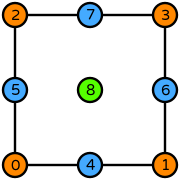Click here to read what the information on this page means.
| Alternative names | P2-iso-P1, iso-P2 P1 |
| Degrees | \(k=1\) |
| Reference cells | interval, triangle, quadrilateral |
| DOFs | On each vertex: point evaluations
On each edge: point evaluations
On each face: point evaluations |
| Number of DOFs | interval: \(3\)
triangle: \(6\)
quadrilateral: \(9\) |
| Number of DOFs on sub-entities | vertices: \(1\)
edges: \(1\)
faces: \(0\) (triangle), \(1\) (quadrilateral) |
| Mapping | identity |
| continuity | Function values are continuous. |
| Categories | Scalar-valued elements, Macro elements |
This element is implemented in
Basix ,
Basix.UFL ,
FIAT , and
Symfem .
↓ Show implementation detail ↓↑ Hide implementation detail ↑| Basix | basix.ElementFamily.iso
↓ Show Basix examples ↓↑ Hide Basix examples ↑Before running this example, you must install Basix: pip install fenics-basix This element can then be created with the following lines of Python: import basix
# Create P1-iso-P2 degree 1 on a interval
element = basix.create_element(basix.ElementFamily.iso, basix.CellType.interval, 1)
# Create P1-iso-P2 degree 1 on a triangle
element = basix.create_element(basix.ElementFamily.iso, basix.CellType.triangle, 1)
# Create P1-iso-P2 degree 1 on a quadrilateral
element = basix.create_element(basix.ElementFamily.iso, basix.CellType.quadrilateral, 1) |
| Basix.UFL | basix.ElementFamily.iso
↓ Show Basix.UFL examples ↓↑ Hide Basix.UFL examples ↑Before running this example, you must install Basix.UFL: pip install fenics-ufl
pip install fenics-basix This element can then be created with the following lines of Python: import basix
import basix.ufl
# Create P1-iso-P2 degree 1 on a interval
element = basix.ufl.element(basix.ElementFamily.iso, basix.CellType.interval, 1)
# Create P1-iso-P2 degree 1 on a triangle
element = basix.ufl.element(basix.ElementFamily.iso, basix.CellType.triangle, 1)
# Create P1-iso-P2 degree 1 on a quadrilateral
element = basix.ufl.element(basix.ElementFamily.iso, basix.CellType.quadrilateral, 1) |
| FIAT | FIAT.Lagrange(..., variant="iso")
↓ Show FIAT examples ↓↑ Hide FIAT examples ↑Before running this example, you must install FIAT: pip install firedrake-fiat This element can then be created with the following lines of Python: import FIAT
# Create P1-iso-P2 degree 1 on a interval
element = FIAT.Lagrange(FIAT.ufc_cell("interval"), 1, variant="iso")
# Create P1-iso-P2 degree 1 on a triangle
element = FIAT.Lagrange(FIAT.ufc_cell("triangle"), 1, variant="iso") Correct: interval,1; triangle,1 Not implemented: quadrilateral,1 |
| Symfem | "P1-iso-P2"
↓ Show Symfem examples ↓↑ Hide Symfem examples ↑Before running this example, you must install Symfem: pip install symfem This element can then be created with the following lines of Python: import symfem
# Create P1-iso-P2 degree 1 on a interval
element = symfem.create_element("interval", "P1-iso-P2", 1)
# Create P1-iso-P2 degree 1 on a triangle
element = symfem.create_element("triangle", "P1-iso-P2", 1)
# Create P1-iso-P2 degree 1 on a quadrilateral
element = symfem.create_element("quadrilateral", "P1-iso-P2", 1) |
- [1] Bercovier, Michel and Pironneau, Olivier. Error estimates for finite element method solution of the Stokes problem in the primitive variables, Numerische Mathematik 33, 211–224, 1979. [DOI: 10.1007/BF01399555] [BibTeX]
| Element added | 06 July 2022 |
| Element last updated | 04 June 2025 |


